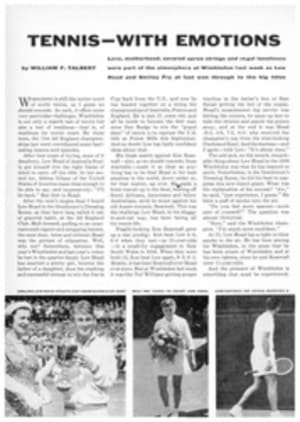
The Pied Piper of Hamelin had nothing on a Frenchman who summons grasshoppers, crows and tree frogs with CALLS OF THE WILD
Dr. Rene-Guy Busnel, a vivacious French physiologist, has been visiting American scientific centers telling his audiences how he can whistle up grasshoppers and provoke numerous other reactions among members of the animal kingdom by subjecting them to a variety of sounds.
In this country certain uses are made of animal responses to sound. Hunters use crow calls, moose calls and duck calls. Bird watchers attract birds with squeaking devices. The recorded and amplified cries of a starling in anguish are used to scare off other starlings. But Dr. Busnel, who is director of the Laboratoire de Physiologie Acoustique of the Institut National dela Recherche Agronomique in France, has delved much deeper into the subject. He is a slender man with upright hair, which gives him a look of chronic astonishment. This serves to emphasize his startling pronouncements.
He recently described how he and his assistants had recorded the distress call of a crow when it was being attacked by a peregrine falcon. Then he showed pictures of them taking a sound truck out into the countryside where they played the recording real loud. Crows came to the truck from two to three miles away and flew around it for 20 minutes, apparently intent upon ganging up on the falcon. They played the sound backwards and still the crows came from afar.
Dr. Busnel's most impressive experiment came when he demonstrated his power over female grasshoppers. First he described how the male grasshopper of this particular species attracts the females during the breeding season by emitting a series of sharp sounds. Then the lights went out and he ran color motion pictures of the experiment.
A Frenchman was stretched prone on the ground blowing repeated blasts on a small, shrill whistle. Some 20 feet away was a female grasshopper. Steadily she crawled toward the whistler, making her way over weeds and grass and sand. Slowly she walked up the Frenchman's arm, onto his face and finally perched on his nose right over the whistle. This was repeated time and again and soon grasshoppers were coming from several directions. One climbed up on the whistler's arm, disappeared behind his neck, then came into view over the top of his head and crawled down his face to the whistle.
At one point two Frenchmen, each with a whistle, stretched out on the sand some 10 feet apart and with a grasshopper between them. They kept calling the grasshopper back and forth until it seemed that the creature would develop schizophrenia.
The physiologist related his surprise during a meeting in his laboratory when a tree frog answered human applause. When the group clapped their hands the frog croaked. This led to more experiments, and Dr. Busnel played a recording of the frog croaking in response to a metronome and to pieces of glass being clanked together.
Going beyond his own experiments Dr. Busnel told how the Chinese repel hawks by putting whistles on the wings of their pigeons; that an automobile horn will make a hippopotamus rise out of the water; that certain sounds will make a crocodile open its mouth; and that African natives attract fish with a crude device which makes sounds under water.
The French scientist was loth to discuss the practical applications of his own discoveries other than to say that the economic uses of some of them were obvious. It is evident that it would be a boon to farmers if they could call crows out of their corn fields. It also is plain that insect pests could be destroyed if the females could be called in at breeding time.
It may not be too farfetched to visualize a fisherman collecting bait by whistling up grasshoppers and crickets. Many people would like to order pigeons out of town and it would be good to impress upon rabbits that they should stay out of the garden. There is plenty that should be conveyed to mice and moles.
ILLUSTRATION

